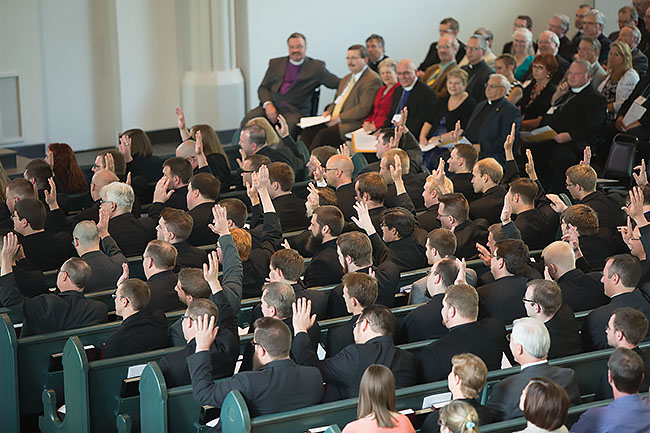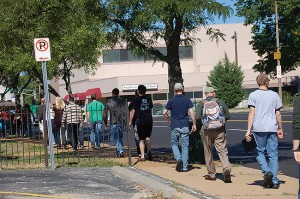
Concordia Seminary Newsroom
Sent to serve

In the very early chapters of Acts, God brings people from various places to Jerusalem in order to connect them with the life-saving message of the risen Christ. So, for example, in Chapter 2 (verses 9-11), people are gathered from the east (“Parthians and Medes and Elamites and residents of Mesopotamia”), from the north (“Cappadocia, Pontus, and Asia”), from the west (“Egypt and the parts of Libya belonging to Cyrene, and visitors from Rome”), and from the south (“Arabians”). The point is that God brings them from many disparate and distant lands to a central place — Jerusalem —where the Gospel is proclaimed to them.

Second-year students raise their hands in response to a question during the vicarage assignment service, April 29, 2015, in the Chapel of St. Timothy and St. Titus.
But as the story of the Church progresses through Acts, the direction by which God moves people reverses. Rather than bringing people to a central place where the Gospel may be heard, God predominantly sends His representatives outward to where other people live. It is to those places and for those people (“for all who are far off,” Acts 2:39) that the Gospel is proclaimed. In other words, God’s servants are sent. They are sent, even as Jesus had commissioned them just before ascending into heaven: “And you will be my witnesses in Jerusalem and in all Judea and Samaria, and to the end of the earth” (Acts 1:8).
Clearly the movement of Christian witness in Acts changes from being one which is largely centripetal — that is, pulling unbelievers toward the gathering of believers — to one that is primarily centrifugal, in which believers go out to where the unbelievers are. The Church is sent for mission (the word “mission” originates from a word meaning “sent”).
The society in which we live is becoming increasingly like that which the early Church encountered in Acts. In many ways the 21st century resembles the first century. North Americans live more and more in what can be described as an unchurched culture. Christianity is not given preferential status. Christians are increasingly regarded as outsiders rather than insiders within this culture, much as they were in the Roman empire of the first century. And so there is the need to adjust our church’s engagement with society. Like the early Christians in Acts, we move from a predominantly centripetal approach (which assumes that people in society will be attracted to what the Church has to offer) to a more centrifugal one (which involves Christians going forth from the assembly into the world and engaging the unchurched in their life contexts).
The Seminary’s role in sending
In many ways, sending is what Concordia Seminary is about. The ultimate purpose of the Seminary is to send church workers — pastors, deaconesses, missionaries, and theological scholars — into the mission field of North America and beyond. Professor Andrew Bartelt is fond of welcoming new students to the Seminary with this greeting: “We are glad that you are here! We can’t wait for you to leave!” This unexpected salutation causes one to pause and to ponder what Seminary education is all about. Indeed, we rejoice when God brings more and more students to study and learn at Concordia Seminary in a kind of centripetal movement. Yet the church rejoices even more when at Call Day these students receive their assignments to go throughout the world and deliver the Gospel to people in their far-flung congregations, communities, and homes. They are sent from St. Louis to be missionaries at places such as Saratoga Springs, N.Y.; Pascagoula, Miss.; Algona, Iowa; Tucson, Ariz.; Kennewick, Wash.; and Mexico City. Such is the centrifugal movement of mission!
The sending of Gospel servants was God’s plan in the first century, and it continues to be His plan in the 21st century. In Rom. 10:13, Paul cites God’s promise that was delivered through the prophet Joel: “Everyone who calls on the name of the Lord will be saved.” But then Paul reminds us that this doesn’t happen unless heralds of the Good News are sent to where “everyone” lives. Paul observes: “How then will they call on him in whom they have not believed? And how are they to believe in him of whom they have never heard? And how are they to hear without someone preaching? And how are they to preach unless they are sent?” (Rom. 10:14-15). How indeed! The centrifugal movement of sending is essential for the life-transforming Gospel to connect with sinners who are distributed throughout the earth. The mission, the sending, is for the sake of the message, the Gospel. And this is all for the sake of the salvation of souls throughout the world.

Participants in the MissionShift Institute trek through different parts of St. Louis on a tour of ministries in the metro area, Sept. 13, 2014.
Sent to serve
If it is true that the Seminary is all about sending, then it is also true that the Seminary graduates are all about serving. Those who are sent forth are sent to serve. Indeed, the very titles which these graduates assume express this truth. A pastor is also a minister, a title which at its root means to serve. A deaconess likewise is a servant; the ascription derives from the New Testament word for one who serves. These workers are sent forth to serve in the pattern of Christ, who “came not to be served but to serve”
(Mark 10:45).
Serving what?
What is it that these servants are sent to serve? Paul provides a clear answer. He again quotes the Old Testament (Is. 52:7) and states: “As it is written, ‘How beautiful are the feet of those who preach the good news!’” (Rom. 10:15). These workers are to be, using one of Martin Luther’s favorite ascriptions, servants of the Word! They are to be those who serve forth faithfully and prolifically the Word of the Gospel! Paul indicates that this serving is through proclamation, and so pastors are taught in the Seminary to preach and teach the messages of Law and Gospel. As appropriate, deaconesses also are equipped to share the Good News in their contexts of serving.
Serving how?
Next, how do these sent servants serve? It is by proclaiming the Good News. But there is another dynamic to the task of serving. Indeed, proclamation of the Gospel is the goal, but this also is accompanied by demonstration of mercy and care. Pastors and deaconesses are distinctively prepared for this service as they demonstrate the love of Christ in word and deed to those who are hurting, needy, ill, injured, aged, ailing, and dying. As is described in Acts, oftentimes the Church’s care for people’s bodily needs lays the groundwork for an openness to spiritual healing through the Word of the Gospel (see Acts 2:44-45, 3:1-26, 4:32-35, 5:12-16, 6:1-7, 9:32-43). Demonstrating love through acts of mercy accompanies the witness of the Word. Serving involves both demonstration and proclamation.
Serving where?
Where do these who are sent by the Seminary serve? The obvious answer is that they are to serve where they are sent. Since most of the graduates of Concordia Seminary are sent to Lutheran congregations that have called them, their service is rendered to the members of those congregations. These saints gather weekly around Word and Sacrament in worship, where pastors preach, lead the liturgy, and administer Baptism and the Lord’s Supper. In this manner, God employs the centripetal movement by bringing people to this central place where He is present, to bestow the forgiveness of sins, life, and salvation, all according to His promise. But the centrifugal motion is also apparent in the service of faithful pastors and deaconesses. These servants have the distinctive privilege and joy of entering into the daily places and the ordinary lives of the flock. They visit members in their homes, workplaces, schools, and other contexts of everyday life. They comfort parishioners in hospitals and nursing homes. Their presence is beyond the premises of the church building. Concordia Seminary seeks to form pastors and deaconesses who embed themselves in the lives of the people to whom they have been sent. The old adage still rings true: “A home-going pastor makes for a church-going people.”
Sent to whom?
Nevertheless, the centrifugal movement doesn’t end there. It is not limited to the members of the congregation, although the pastor should never neglect them. Instead, the movement extends even farther into the wider community. For it is to the lost, as well as to the found, that Seminary graduates are sent. Jesus stated that He was sent to seek and to save the lost (Luke 19:10). Christ lived among those who were not regarded as part of the religious institutions of the first century, showing love and mercy to those who were considered to be sinners by the ecclesial establishment (Mark 2:15-17; Luke 15:1-7). Now He sends pastors to do the same (John 20:21). They are sent to serve those beyond the premises of the church property and into the lives of those lost in unbelief. They are to incarnate Christ in the broader community beyond the congregation of believers. This is especially important today in this “post-Christian” society in which many people question the value and relevance of Christ. It is this mission, the mission to those who have not believed and who have never heard, that Paul refers to in Rom. 10:14-15. As it was in the first century, so it is now in the 21st century. It is to the lost — as well as to those found in Christian congregations — that pastors, deaconesses, and missionaries are sent to serve.